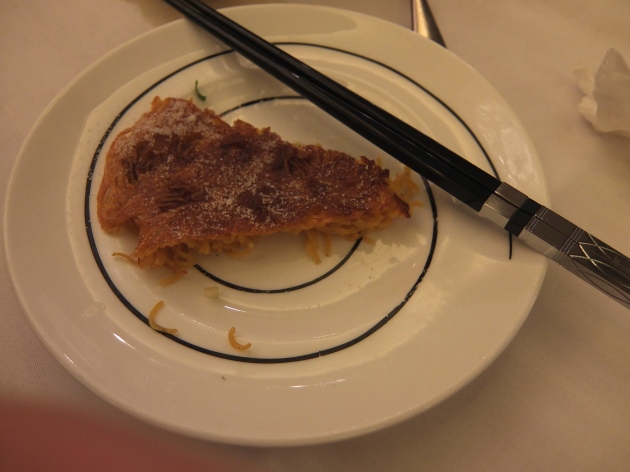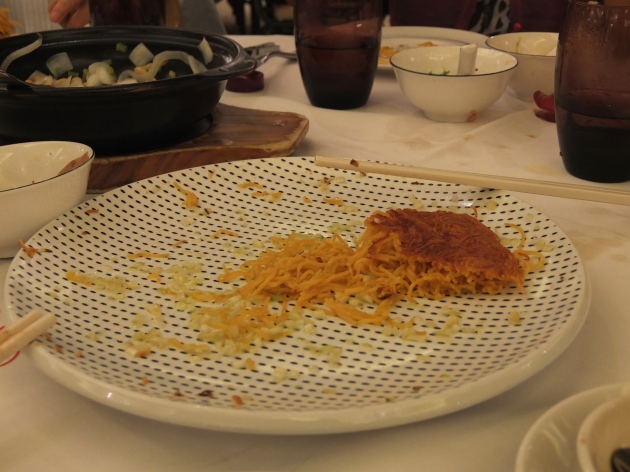Noodle cake. Yes, you heard me. Forget ramen, stir-fry, or glass noodles in peking pancakes. (Well, don’t forget them all together, because they are all great ways to eat your noodles).
Noodle cake is one of those dishes I wish I could explain the simple joys of to my friends. Few get as enthused as I do, however. The last time I had noodle cake was sadly just coming to a year ago – I had finished A Levels, and so off to Hong Kong I went, to dutifully fulfil the work experience I promised UCAS I would.
Who wouldn’t enjoy getting some work experience under their belt and then having the opportunity to blow that hard-earned dough on fake Mulberry in Monkok Market? The dress that features in the photos below was another market purchase from previously in the day, where two adorable old women ironed the creases out of it and let me reappear from the shop as a cleaner, crisper woman. Nevertheless, although shopping heaven, Hong Kong to me is really all about food.
The restaurant my lovely Chinese fam chose to frequent was Chiu Chow Garden, standard posh dining spot with glittering chandeliers, and a huge round table complete with lazy susan (that spiny wheel that means you don’t really have to move to get to the dishes you want. Quick). As per usual we waited for the food to arrive before taking the first photo of the ‘whole’ family together in years, standing professionally and smiling behind a laden table that screamed “Look at how much we like good food!” “Look at how we like sharing said good food!” An empty table in restaurant-themed photograph raises serious questions.
As a half-savoury, half-sweet concoction, the noodle cake featured between courses. After the half-pudding we ordered yet more pudding, although we were all full…but we did, because we could. (When I say ‘we’ I mean my very kind Uncle).
Mmmm. Super crispy on the outside, soft and chewy on the inside (is ‘noodley’ a word?) Sprinkle it with a generous teaspoon of white sugar and a glug of malt vinegar and you get a match made in caramelised heaven. I like to think of noodle cake as the yin to the yang of the simple yet delicious crepe with lemon juice and sugar. But it’s better, because it arguably twists the boundaries between savoury and sweet further. The vinagar gives it a nice kick, so it’s kind of like the crepe’s older, rebelious brother. And we all know how I like those bad boys.
Anyway, back to the restaraunt. Washing that noodle cake down with shots of very strong oolong tea and I was up all night. Dreaming of how I would recreate that noodley thang upon my eventual return to England.
So, here they are. Mumma Cooper’s tips (my mother, I mean, I haven’t afforded myself a new nickname here) for frying those noodles. Please be aware I don’t pretend to know the inns and outs of the very complex art of Chinese cooking, however, I only seek to share the simple things I have learnt of my own mum, which she in turn observed from religiously watching her maid feed a family of 10 (10? 9? I can’t keep track, sorry mum).
THE BEST STIR-FRY EVER
1. Work out which vegetables are the ‘hardest’
In order to get your stir-fry to boast crunchy veg (which I personally prefer), work out which veggies are the hardest. Examples of hard vegetables include broccoli and carrots, whilst softer vegetables a watery ones like bak choi and bean sprouts. The hardest veggies cook longer and so you can toss them in at the beginning, once you’ve oiled the wok. The softer veggies will go soggy if also added at this stage, so save tossing them in until the end, where it only takes a minute or two for them to cook to the perfect consistency.
2. Wash AND RINSE those noodles!
Come on people, don’t be lazy. The straight-to-wok noodles you get in the supermarket aren’t as good, and preparing fresher, better ones couldn’t be more easy. This type usually requires soaking (see packet for details), but make sure you also rinse them in cold water right before you fry up. Otherwise those lovely vermicelli in your Shanghai creation are going to procure a sticky texture.
3. Perfect the base
A little oil, a sauce of your choosing, chopped garlic and a dash of dry spice all go in to the pan to start the flavour party – experiment with the flavours you love.
As for the adventurous ones out there…
TIME FOR NOODLE CAKE
1. Don’t be greedy
Your eyes are always bigger than your belly – if you’re cooking for a bigger bunch of people, cancel the invites. A best noodle cakes tend to be the smallest.
2. Prep your noodles as above
Do exactly the same with washing and rinsing as you would in a stir-fry, but this time using a specific type – thin, egg-noodles work the best.
3. Use a small pan
Same as before, smaller is better.
4. Turn up the heat
Cook that baby hot and quick.
5. Don’t overdo the oil
My mum wasn’t so clear with her guidance here, so I may update this when I have the chance to cook one again with her. You need to swill enough oil in your pan so that when you dump the rinsed noodles in and press them down with a spatula “like a pizza,” they will crisp up. However, you don’t want to use a ridiculous amount and end up with a “greasy soggy grease cake.”
6. Halfway through, turn over with two spatulas
This is the part that requires a bit more skill. Bet you are wishing you had listened to me earlier when I told you to make a small one, aren’t you?
7. Enjoy!
Serve cut into pizza shaped slices with sugar (my mum uses raw brown cane sugar) and malt vinegar on top. Alternatively, make a small noodle cake with a portion of your regular veggie stir-fry and crush the crunchy bits on top when you serve, for a bit of pizazz!
I hope this post on my second-favourite carb has been able to enlighten a few of you.
– Alissa xo




